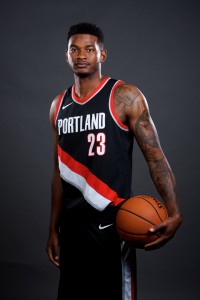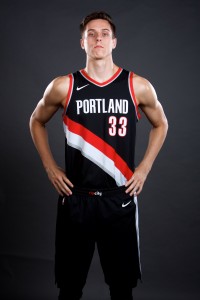Hoops Rumors is breaking down the 2017 offseason for all 30 NBA teams, revisiting the summer’s free agent signings, trades, draft picks, departures, and more. We’ll evaluate each team’s moves from the last several months and look ahead to what the 2017/18 season holds for all 30 franchises. Today, we’re focusing on the Portland Trail Blazers.
Signings:
- C.J. Wilcox: Two-way contract. One year. $50K guaranteed.
Camp invitees:
- Isaiah Briscoe: One year, minimum salary. Exhibits nine and 10. (Waived)
- Archie Goodwin: One year, minimum salary. Exhibit nine. (Waived)
- Anthony Morrow: One year, minimum salary. Summer contract. (Waived)
Trades:
- Acquired the draft rights to Zach Collins (No. 10 pick) from the Kings in exchange for the draft rights to Justin Jackson (No. 15 pick) and Harry Giles (No. 20 pick).
- Acquired cash ($100K) from the Rockets in exchange for Tim Quarterman.
- Acquired Andrew Nicholson from the Nets in exchange for Allen Crabbe.
- Note: Nicholson was later waived.
Draft picks:
- 1-10: Zach Collins — Signed to rookie contract.
- 1-26: Caleb Swanigan — Signed to rookie contract.
Departing players:
- Allen Crabbe
- Festus Ezeli (waived)
- Tim Quarterman
Other offseason news:
- Extended president of basketball operations Neil Olshey through 2021.
Salary cap situation:
- Operating over the cap and over the tax line by approximately $3MM. Carrying approximately $122MM in guaranteed team salary. Full taxpayer mid-level exception ($5.192MM) still available.
Check out the Portland Trail Blazers’ full roster and depth chart at RosterResource.com.
Story of the summer:
Most NBA teams head into the offseason looking to improve their respective rosters by spending money, but that wasn’t necessarily the case for the Trail Blazers, whose primary goal over the summer was to trim their projected team salary.
The summer of 2016 loomed large over the 2017 offseason for the Blazers, who handed out lucrative long-term contracts to several free agents in ’16. Not all of those deals look awful a year later, but the team probably wouldn’t turn down the opportunity to take many of them back, including huge multiyear investments in Meyers Leonard, Evan Turner, and Allen Crabbe.
Portland entered the offseason with $133MM+ in guaranteed team salary on the books for 2017/18, not including cap holds for the club’s three first-round picks. By the time the dust settled and the regular season roster was set, the Blazers had sliced that number by more than $10MM, exponentially reducing the franchise’s projected luxury tax bill. So, in at least one sense, the club’s offseason was a success.
Key offseason losses:
The transaction that was responsible for reducing the Trail Blazers’ team salary most significantly was the trade that sent Crabbe to the Nets in exchange for Andrew Nicholson. Crabbe was a productive wing for the Blazers in 2016/17, setting new career highs in PPG (10.7), FG% (.468), and 3PT% (.444), among other categories. However, he was set to earn $19.3MM this season and $56MM+ in total over three years, making him a logical trade chip.
The Nets, who originally signed Crabbe to his current contract in the form of an offer sheet last year, were happy to take him off the Blazers’ hands, ditching Nicholson’s unwanted contract on Portland as part of the deal. Portland waived and stretched Nicholson’s contract, reducing his cap hit to just $2.844MM. But Nicholson will count against the Blazers’ cap for that amount for the next seven seasons. In the end, it probably would’ve been in the Blazers’ best interests to just let Brooklyn have Crabbe when he first signed his offer sheet with the club in 2016.
Outside of Crabbe, there were no major departures for the Blazers, who also traded Tim Quarterman and waived Festus Ezeli. Quarterman only played 80 total minutes for Portland in his rookie season, while Ezeli never appeared in a single game for the franchise, having been sidelined with a career-threatening knee injury.
Key offseason additions:
There were several NBA teams that essentially sat out the free agent period in July, but none were less active than the Trail Blazers. Portland was the lone NBA club that didn’t sign a single player to a guaranteed NBA contract this offseason. The team’s only signings were three training camp invitees – all of whom were later waived – and two-way player C.J. Wilcox (the club also inked Wade Baldwin to a two-way deal after the regular season got underway).
Although they have no incoming veterans to incorporate into the lineup, the Blazers did add a pair of potential core pieces in the draft. Using the 15th and 20th overall picks, Portland traded up to No. 10 to snag Gonzaga big man Zach Collins, and then selected power forward Caleb Swanigan with the No. 26 pick.
While Collins wouldn’t have been my choice at No. 10, with Malik Monk and Donovan Mitchell still on the board, he should be a good fit in Portland. Jusuf Nurkic will handle starting duties in the middle, but Nurkic has battled some health problems this year, and the Blazers don’t have a reliable backup at center after Leonard struggled and Ezeli failed to pan out last season.
As for Swanigan, the Purdue alum was one of my favorite prospects in this year’s draft class after he averaged a double-double (18.5 PPG, 12.5 RPG) and shot 44.7% on three-pointers in his sophomore season. Despite only being 20 years old, Swanigan looks ready to step in and play a rotation role in Portland right away.
Outlook for 2017/18:
While ownership must be happy to see the Blazers’ projected luxury tax bill decline so significantly, the club’s approach to the offseason and its lack of cap flexibility made it difficult to upgrade the roster. President of basketball operations Neil Olshey and company did okay given their limited options — there’s some value in continuity, and Portland’s new rookies are promising. I do expect the club to be a solid playoff contender in 2017/18.
Still, after a season in which Portland struggled to earn the No. 8 seed in the Western Conference, the team’s ceiling may not be much higher than that in the short term, given the lack of offseason modifications to the roster.
Salary information from Basketball Insiders used in the creation of this post. Photos courtesy of USA Today Sports Images.